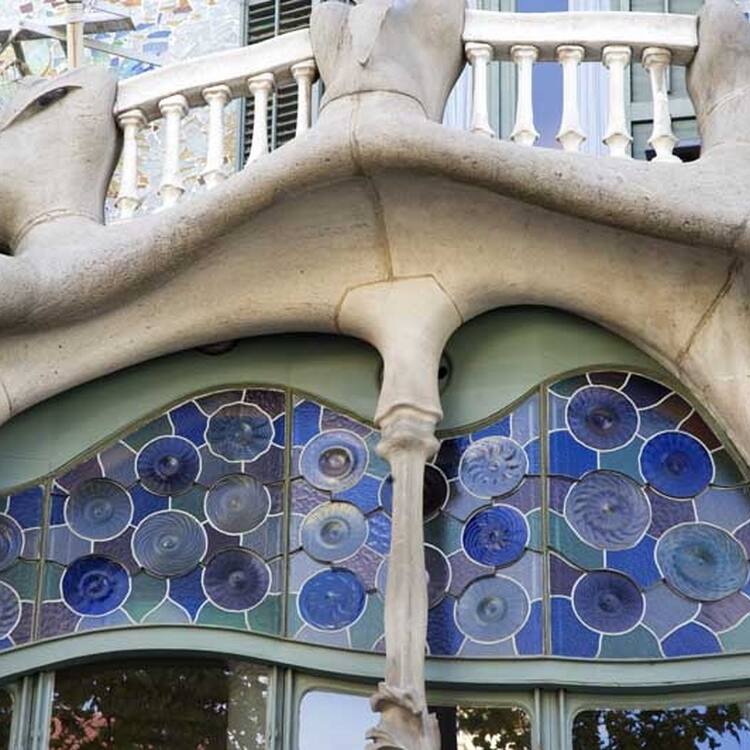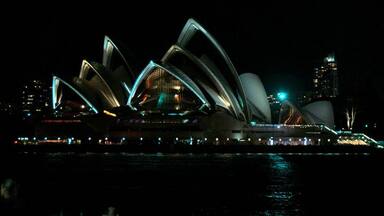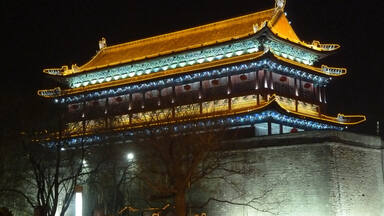Works of Antoni Gaudí
Works of Antoni Gaudí
Seven properties built by the architect Antoni Gaudí (1852–1926) in or near Barcelona testify to Gaudí’s exceptional creative contribution to the development of architecture and building technology in the late 19th and early 20th centuries. These monuments represent an eclectic, as well as a very personal, style which was given free reign in the design of gardens, sculpture and all decorative arts, as well as architecture. The seven buildings are: Parque Güell; Palacio Güell; Casa Mila; Casa Vicens; Gaudí’s work on the Nativity façade and Crypt of La Sagrada Familia; Casa Batlló; Crypt in Colonia Güell.
Description is available under license CC-BY-SA IGO 3.0
Œuvres d’Antoni Gaudí
Sept biens construits par l’architecte Antoni Gaudí (1852-1926), à Barcelone ou à proximité, inscrits sur la Liste du patrimoine mondial en 1984 témoignent de la contribution créative exceptionnelle de Gaudí au développement de l’architecture et des techniques de construction à la fin du XIXe et au début du XXe siècle. Ces monuments sont l’expression d’un style à la fois éclectique et très personnel qui s’est donné libre cours non seulement dans l’architecture mais aussi dans l’art des jardins, la sculpture et toutes les formes d’arts décoratifs. Les 7 bâtiments sont : le parc Güell, le palais Güell, la Casa Mila, la Casa Vicens, le travail de Gaudí sur la façade de la Nativité et la crypte de la cathédrale de la Sagrada Familia, la Casa Batlló, la crypte de la Colònia Güell.
Description is available under license CC-BY-SA IGO 3.0
أعمال أنطوني غاودي
أملاك سبعة بناها المهندس أنطوني غاودي (1852-1926) في برشلونة أو على مقربة منها وهي مدرجة على قائمة التراث العالمي عام 1984 وتجسّد مساهمة غاودي المبدعة في تطوّر الهندسة وتقنيّات البناء أواخر القرن التاسع عشر ومطلع القرن العشرين. وتشكّل هذه التحف خير تعبير عن طراز انتقائي وشخصي أطلق فيه العنان لذاته ليس فقط في الهندسة وإنما أيضاً في فنّ الحدائق والنحت ومختلف أشكال الفنون التزينييّة. والمباني السبعة هي منتزه غويل، قصر غويل، كاسا ميلا، كاسا فيسنس، أعماله في مشهد الميلاد وقاعة كاتدرائية العائلة المقدسة وكاسا باتلو ومدفن كولونيا غويل.
source: UNESCO/CPE
Description is available under license CC-BY-SA IGO 3.0
安东尼•高迪的建筑作品
在巴塞罗那市区或近郊的7处安东尼·高迪的建筑作品,见证了他对19世纪末和20世纪初建筑技术的杰出创意与贡献。圭尔公园、圭尔宫、米拉大楼、文生宅圣家大教堂、巴特里奥之家和克洛尼亚古埃尔宫,这些建筑物都呈现了折衷主义风格,非常人性化,这对花园、雕塑以及所有装饰艺术和建筑的设计产生了极大影响。
source: UNESCO/CPE
Description is available under license CC-BY-SA IGO 3.0
Произведения Антонио Гауди (Барселона и окрестности)
Четыре здания, построенные архитектором Антонио Гауди (1852-1926) в Барселоне и ее окрестностях, стали добавлением к его парку Гуэль, дворцу Гуэль и дому Каса Мила в Барселоне, включенным в Список всемирного наследия в 1984 г. Здания подтверждают исключительный творческий вклад Гауди в развитие архитектуры и строительной техники в конце ХIХ - начале ХХ вв. Эти памятники представляют эклектичный и, в то же время, очень индивидуальный стиль, который выразился в проектировании парков, скульптуре и всех видах декоративного искусства, также как и в архитектуре. Этими четырьмя зданиями являются: Каса Висенс (1883-1885 гг.); часть работ Гауди по церкви Саграда-Фамилия, (1884-1926 гг. - фасад Рождества и крипта); Каса Батло (1904-1906 гг.) и крипта в Колонии Гуэль (1898-1905 гг.).
source: UNESCO/CPE
Description is available under license CC-BY-SA IGO 3.0
Obras de Antoni Gaudí
Siete edificios construidos por el arquitecto Antoni Gaudí (1852–1926) en Barcelona o sus proximidades. Inscritos en la Lista del Patrimonio Mundial en 1984 y 2005. Estas obras atestiguan la excepcional contribución de las creaciones de Gaudí a la evolución de la arquitectura y las técnicas de construcción a finales del siglo XIX y principios del XX. Son la expresión de un estilo ecléctico y sumamente personal al que su autor dio rienda suelta no sólo en la arquitectura, sino también en la jardinería, la escultura y muchas otras artes decorativas. Los siete edificios son: Parque Güell, Palacio Güell, Casa Milá, Casa Vicens, la obra de Gaudí en la fachada de la Natividad y la cripta de la Sagrada Familia, la Casa Batlló y la cripta de la Colonia Güell.
source: UNESCO/CPE
Description is available under license CC-BY-SA IGO 3.0
アントニ・ガウディの作品群
source: NFUAJ
Werken van Antoni Gaudí
Source: unesco.nl
Outstanding Universal Value
Brief synthesis
The Works of Antoni Gaudí is a serial property consisting of seven buildings by the architect Antoni Gaudí (1852–1926) located in Barcelona and its surrounding areas. The property attests to the exceptional creative contribution of this architect to the development of architecture and construction technology in the 19th and early 20th centuries. The Park Güell, the Palau Güell, the Casa Milà-La Pedrera, the Casa Vicens, the Nativity Façade and the Crypt of the Sagrada Família, the Casa Batlló, and the Crypt of the Colònia Güell reflect an eclectic, very personal style to which Gaudí gave free rein in the field of architecture, as well as in the design of gardens, sculptures, and indeed all the arts.
The Works of Antoni Gaudí is an exceptional and outstanding creative contribution to the architectural heritage of modern times. His work is rooted in the particular character of the period, drawing on the one hand from traditional Catalan patriotic sources and on the other from the technical and scientific progress of modern industry. Gaudí’s work is a remarkable reflection of all these different facets of society and has a unique and singular character. In fact, his works are particularly associated with Modernisme, and in this sense, Gaudí can be regarded as the most representative and outstanding of the Modernista architects.
Gaudí’s work is an exceptional creative synthesis of several 19th-century artistic schools, such as the Arts and Crafts movement, Symbolism, Expressionism, and Rationalism, and is directly associated with the cultural apogee of Catalonia. Gaudí also presaged and influenced many forms and techniques of 20th-century Modernism.
Criterion (i): The work of Antoni Gaudí represents an exceptional and outstanding creative contribution to the development of architecture and building technology in the late 19th and early 20th centuries.
Criterion (ii): Gaudí's work exhibits an important interchange of values closely associated with the cultural and artistic currents of his time, as represented in el Modernisme of Catalonia. It anticipated and influenced many of the forms and techniques that were relevant to the development of modern construction in the 20th century.
Criterion (iv): Gaudí's work represents a series of outstanding examples of the building typology in the architecture of the early 20th century, residential as well as public, to the development of which he made a significant and creative contribution.
Integrity
In general, all the component parts of the property enjoy a high degree of integrity and have retained a good relationship with their surroundings, whether urban or natural.
The Palau Güell, originally a family home, is now a cultural and tourist facility that retains its architectural integrity, form, and original decoration. The Park Güell is still used as a public park and green space, the purpose for which it was designed; now combining this with tourist and cultural use, while conserving the original features in their entirety. The Casa Milà-La Pedrera and the Casa Batlló, a pre-existing building remodelled by Gaudí, largely conserve their original design as apartment buildings, combining this in present day with other uses, such as offices and cultural and tourist facilities. Some monuments, such as the Casa Vicens, have retained over time both their physical appearance and their use as family homes. The Crypt of the church of the Colònia Güell is the only component to have been built as part of a larger project for the church. Subsequently, a temporary roof was erected over the Crypt. The present roof maintains the overall integrity of the Crypt as constructed by Gaudí. It also currently retains its use as the church of the Colònia Güell. In the case of the Sagrada Família, the integrity of the part built by Gaudí is intact. Furthermore, its current function as a church corresponds with the use originally intended, maintaining its religious symbolism and being a landmark for the city of Barcelona.
Authenticity
In general, all the buildings by Antoni Gaudí that are part of the serial property possess a fair degree of authenticity. Restoration works have reflected these qualities in the conditions for interventions.
The Palau Güell has undergone a general restoration to improve its conservation and enhance its cultural use, highlighting the authenticity of its architectural and decorative features. The Park Güell has undergone a variety of minor and structural restorations to repair damage caused by its intensive public use and exposure to the elements. The Casa Milà-La Pedrera has been comprehensively restored to improve its state of conservation, highlight certain unique features such as the roof, attics, “noble” floor, etc., and to make it more suitable for cultural uses and public visits. The Casa Vicens has undergone only minor conservation and restoration work. The Casa Batlló has been restored to improve its state of conservation and enhance its use for cultural purposes.
At the Crypt of the Colònia Güell, the structure has been restored, preserving and consolidating Gaudí’s Crypt, substituting the stairs and the deteriorating temporary roof. The new roof is based on modern design criteria and does not interfere with visibility from the surrounding area. There were also structural problems, due to the fact that the columns were not receiving the load they were originally designed to take. Nonetheless, the work by Gaudí in the Crypt has been correctly restored and has not lost its originality.
In the case of the Sagrada Família, the authenticity of the part built by Gaudí – the Nativity Façade and the Crypt – has been preserved in terms of its material, form, and workmanship.
Construction work on the church is continuing at the present time. The work originally performed by Gaudí must be considered in the context of the overall project that he himself had planned, which is now close to being brought to completion in accordance with the evidence and guidelines that have been drawn up and scientifically verified.
Protection and management requirements
Protection legislation includes Law 16/1985 of 25 June concerning Spanish Historical Heritage, Law 9/1993 of 30 September concerning Catalan Cultural Heritage, and Decree 276/2005 concerning Territorial Commissions for the Cultural Heritage. Legislation at the municipal level, including the Metropolitan General Plan, the Special Plan to protect the architectural heritage of the city of Barcelona, and the Special Plan to protect the architectural heritage of the Colònia Güell residential district, grants additional protection.
In terms of management, there are numerous authorities involved in decision making at the levels of the State, the Autonomous Community, and the municipality. Similarly, ownership is varied: Park Güell is owned by the Barcelona City Council, Palau Güell by the Barcelona Provincial Council, Casa Milà-La Pedrera by the Fundació Catalunya - La Pedrera, and Casa Vicens is private property. Casa Batlló is owned by Inmobiliaria Casa Batlló SL, Sagrada Família by the Board of the Sagrada Família, and the Crypt of the Colònia Güell by Colònia Güell Consortium. Management of the property also has to reconcile diverse uses such as public garden (Park Güell), culture and tourism, and religious and residential use.
The Territorial Commission for the Cultural Heritage of Barcelona and the Territorial Commission of the city of Barcelona are ultimately responsible for the management and administration of the inscribed property, in accordance with the legislative and regulatory framework. In addition, different component parts have specific conservation, maintenance, and master plans to address particular conditions. The management of the property will need to respond effectively to the increased pressure from the growing number of visitors and continue its work on the protection and restoration of the structural and decorative elements, with attention paid to the behaviour and decay processes of the materials used (iron, ceramics, etc.).

 View photos from OUR PLACE the World Heritage collection
View photos from OUR PLACE the World Heritage collection


